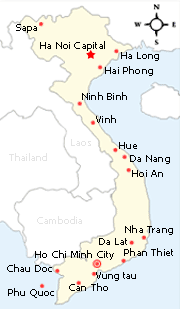|
Hilltop harvest celebrations
Dragon dance is one of the more common dances performed during the harvest festivities Hau Duc Nhanh, a young man of the ethnic San Chi community in Phu Luong District, wakes up before dawn. He gets up early everyday to go the rice fields but today is a special occasion. The highland air is chilly in the morning. Nhanh washes quickly and puts on his traditional costume because he has been chosen by the village to perform the ceremonial tac xinh dance with other young men in the biannual New Rice Festival. The San Chi people celebrate the festival, called Slech thlin may at the beginning of summer and at year’s end, marking the summer-fall and the winter-spring crops respectively. At 7 a.m., people from Nhanh’s community and neighboring areas assemble at an open space in front of the village. They form a procession, led by elders wearing ceremonial robes. Behind the elders are young men carrying food trays and alcohol to offer to the gods. They are followed by some local officials and villagers who wear their most beautiful and colorful clothes. The procession heads to the Earth Lord temple, located a short distance away in the forest Village chief Hau Van Dao, 66, burns incense and reads prayers to many deities, thanking them for a good harvest and also praying for a good crop next time. At 8 a.m., Nhanh, wearing his yellow costume, and another young man, Hau Tien Dac wearing a red outfit, start the dance, gyrating to the energetic rhythm of the music, the crowd watches and cheers. Symbolic dance Nhanh says tac xinh dance has seven basic movements symbolizing the San Chi people’s farming life. “The moves imitate looking for paths through the mountains, clearing paths, sharpening knives, clearing land for cultivation, planting rice seeds, caring for the rice, harvesting crops, celebrating bumper crops, and bowing to the gods,” he says. “We believe the more enthusiastic and precise the dancers and musicians perform, the more the gods would bless us for better crops,” he said. “The dance should be performed exactly the way that it has been handed down through the generations,” says village elder Dao. Local Party Unit Chief Hau Van Luong said the name tac xinh is derived from "tac xich" in San Chi language, it means "edible," or “allowed to eat.” The dance also symbolizes fertility along with agricultural production. “The dance also aims to commemorate ancestors. It is the bridge to link the universe with human beings, to link the world of the living to the underworld, the previous generations with the next generations. It also reinforces the villager’s belief that they can conquer nature,” Luong said. Main performances of tac xinh can consist of two, four or six men. In past only men could perform but now it is open to women. Local musicians keep the rhythm for tac xinh dancers by using bamboo poles and a special “earth-drum.” The “earth-drum” is a hole, 60cm deep with a 50 cm diameter covered with tree bark. Musicians use a bamboo pole to beat on the bark to create sound. Each player holds a 1.8m long bamboo pole in one hand to beat on the “earth-drum” to create sound “xich.” They hit the pole with another smaller bamboo stick to create the sound “tach.” The dancers perform a series of dance movement following a series of sounds “tach tach xich – tach tach xich – tach xich.” Other instruments such as cymbals, wind instruments and small drums, are also played. Local communal official Le Minh Thao said the dance praises the hard working life of the San Chi. “The dance is really an art of the ordinary people. It has originated from daily life and work. It has turned working lives into cultural values,” he said. The San Chi tribe is a part of the San Chay ethnic minority people who farm the mountains and forests of the northern highlands. They have many rituals related to their farming tradition and their relationship with nature. The New Rice Festival is the most important among San Chi cultural and religious activities. People hold the festival to say thank you to heaven, earth, and the deities who gave them rain and favorable weather, good crops and prosperous healthy people. The ceremony is also a chance for the San Chi to celebrate before entering a new season. Festivities While the rituals and ceremonial dance must conform strictly to tradition, the subsequent festive activities are open for everyone. Dances during the festival including the dragon dance are simpler, mostly reflecting community life. Villagers also play traditional games, including throwing con (a colorful ball) through a ring on top of a high bamboo pole and top spinning. A few young men also challenge each other to standing-on-their-head competitions. The event, especially the dances, has helped many young people meet and then become couples, said Hau Duc Nhanh. “That’s why we consider the festival like the sweet fruits of harmony between Yin and Yang, between the nature and human beings,” he said. While the dancing continues, people invite each other to enjoy rice wine and food - laughter echoes through the village until midnight. Other news for Thursday 06 August, 2009
View all news for Thursday 06 August, 2009 on one page News for Monday 27 July, 2009 View all news for Monday 27 July, 2009 on one page Recent News
|










